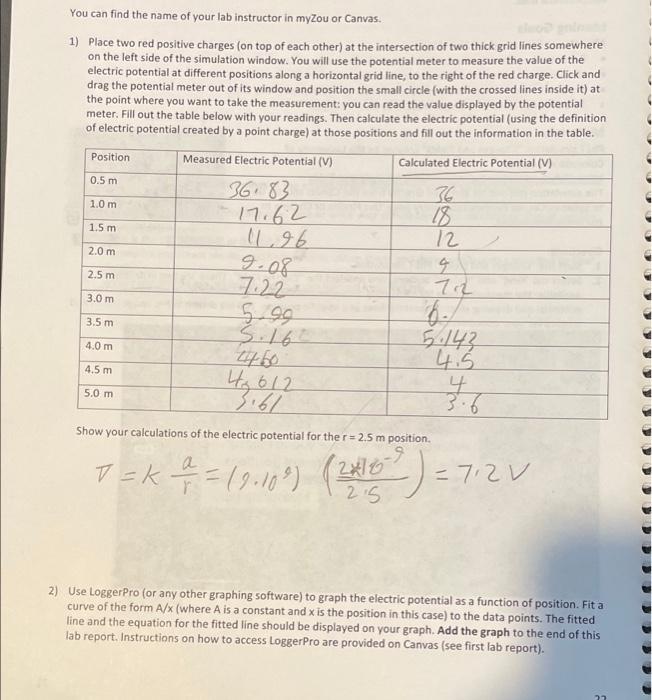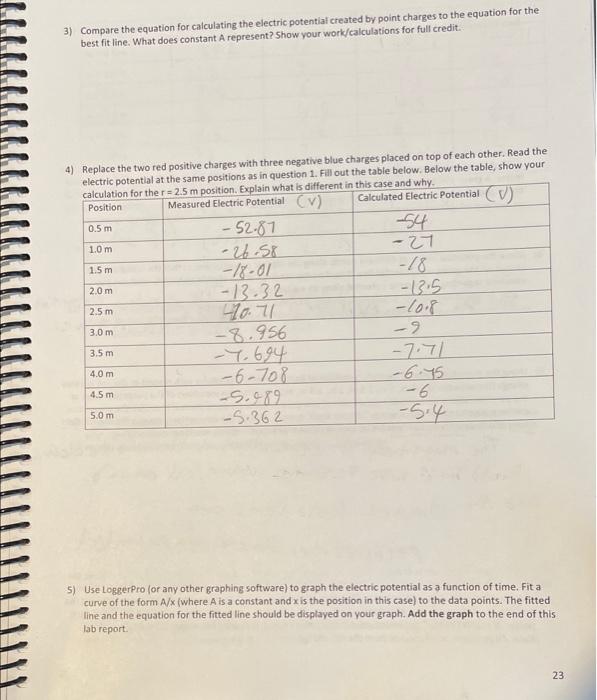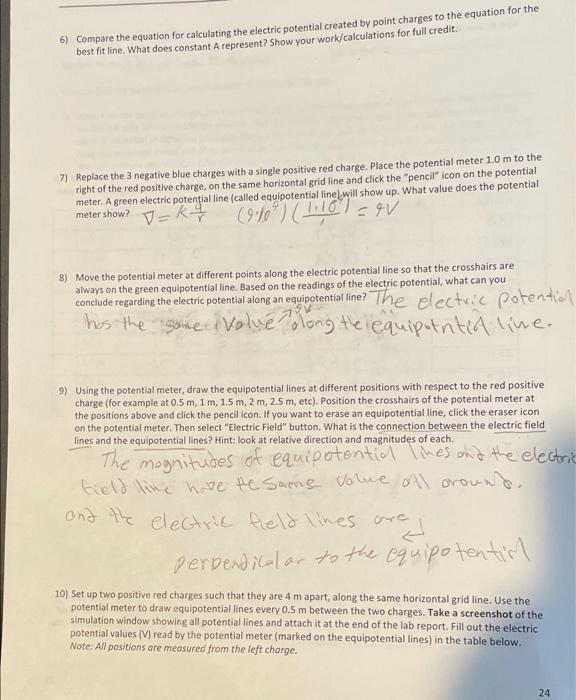Answered step by step
Verified Expert Solution
Question
1 Approved Answer
You can find the name of your lab instructor in myZou or Canvas. 1) Place two red positive charges (on top of each other)



You can find the name of your lab instructor in myZou or Canvas. 1) Place two red positive charges (on top of each other) at the intersection of two thick grid lines somewhere on the left side of the simulation window. You will use the potential meter to measure the value of the electric potential at different positions along a horizontal grid line, to the right of the red charge. Click and drag the potential meter out of its window and position the small circle (with the crossed lines inside it) at the point where you want to take the measurement: you can read the value displayed by the potential meter. Fill out the table below with your readings. Then calculate the electric potential (using the definition of electric potential created by a point charge) at those positions and fill out the information in the table. Measured Electric Potential (V) Calculated Electric Potential (V) 36.83 17.62 11,26 Position 0.5 m 1.0 m 1.5 m 2.0 m 2.5 m 3.0 m 3.5 m 4.0 m 4.5 m 5.0 m 9.08 7.22 5.99 S.16 4612 3.61 36 18 12 4 722 5.143 4.5 4 3.6 Show your calculations of the electric potential for the r= 2.5 m position. 7 = K = = (9-18") (2016-2 ) = 72V 17.10% 2) Use LoggerPro (or any other graphing software) to graph the electric potential as a function of position. Fit a curve of the form A/x (where A is a constant and x is the position in this case) to the data points. The fitted line and the equation for the fitted line should be displayed on your graph. Add the graph to the end of this lab report. Instructions on how to access LoggerPro are provided on Canvas (see first lab report). 3) Compare the equation for calculating the electric potential created by point charges to the equation for the best fit line. What does constant A represent? Show your work/calculations for full credit. 4) Replace the two red positive charges with three negative blue charges placed on top of each other. Read the electric potential at the same positions as in question 1. Fill out the table below. Below the table, show your calculation for the r= 2.5 m position. Explain what is different in this case and why. Position Measured Electric Potential (V) Calculated Electric Potential (V) 0.5 m 1.0 m 1.5 m 2.0 m 2.5 m 3.0 m 3.5 m 4.0 m 4.5 m 5.0 m -52-87 -26-58 -18-01 -13.32 40.71 -8.956 -7.694 -6-708 -5.989 -5.362 -54 -27 -18 -13.5 -10.8 -9 -7.71 -6.75 -6 -5.4 5) Use LoggerPro (or any other graphing software) to graph the electric potential as a function of time. Fit a curve of the form A/x (where A is a constant and x is the position in this case) to the data points. The fitted line and the equation for the fitted line should be displayed on your graph. Add the graph to the end of this lab report. 23 6) Compare the equation for calculating the electric potential created by point charges to the equation for the best fit line. What does constant A represent? Show your work/calculations for full credit. 7) Replace the 3 negative blue charges with a single positive red charge. Place the potential meter 1.0 m to the right of the red positive charge, on the same horizontal grid line and click the "pencil" icon on the potential meter. A green electric potential line (called equipotential line will show up. What value does the potential V=k+ meter show? (9-10) (110) =9V 8) Move the potential meter at different points along the electric potential line so that the crosshairs are always on the green equipotential line. Based on the readings of the electric potential, what can you conclude regarding the electric potential along an equipotential line? The electric potential has the same Value Tolong the equipoentid live. 9) Using the potential meter, draw the equipotential lines at different positions with respect to the red positive charge (for example at 0.5 m, 1 m, 1.5 m, 2 m, 2.5 m, etc). Position the crosshairs of the potential meter at the positions above and click the pencil icon. If you want to erase an equipotential line, click the eraser icon on the potential meter. Then select "Electric Field" button. What is the connection between the electric field lines and the equipotential lines? Hint: look at relative direction and magnitudes of each. The magnitudes of equipotential lines and the electric bield line have the same volue all around. and the electric field lines are perpendical ar to the equipotential 10) Set up two positive red charges such that they are 4 m apart, along the same horizontal grid line. Use the potential meter to draw equipotential lines every 0.5 m between the two charges. Take a screenshot of the simulation window showing all potential lines and attach it at the end of the lab report. Fill out the electric potential values (V) read by the potential meter (marked on the equipotential lines) in the table below. Note: All positions are measured from the left charge. 24
Step by Step Solution
★★★★★
3.40 Rating (150 Votes )
There are 3 Steps involved in it
Step: 1

Get Instant Access to Expert-Tailored Solutions
See step-by-step solutions with expert insights and AI powered tools for academic success
Step: 2

Step: 3

Ace Your Homework with AI
Get the answers you need in no time with our AI-driven, step-by-step assistance
Get Started


